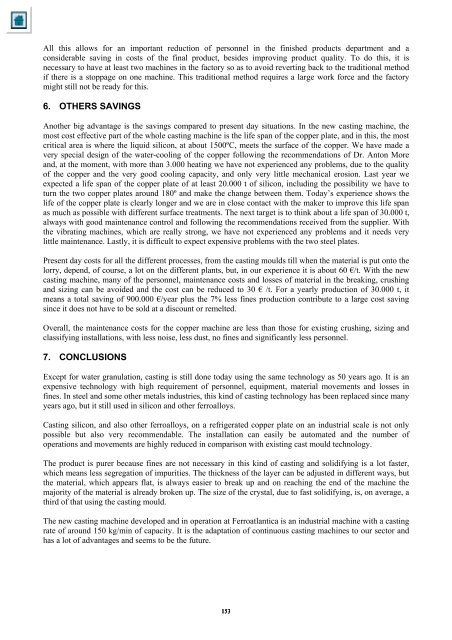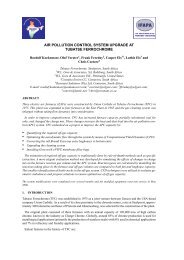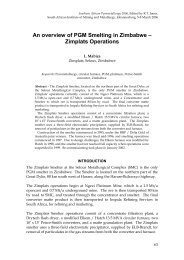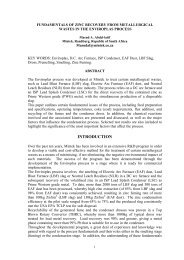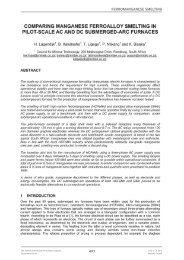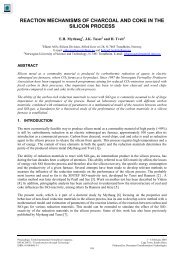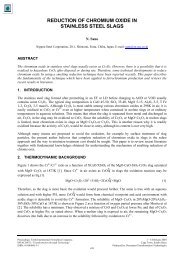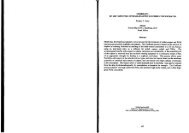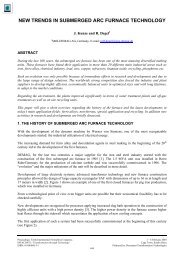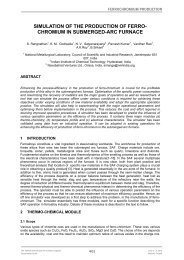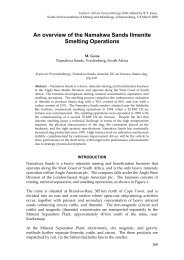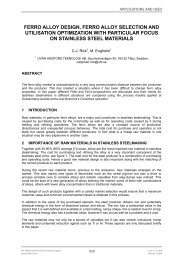The New Copper Casting-Machine: Experiences at ... - Pyro.co.za
The New Copper Casting-Machine: Experiences at ... - Pyro.co.za
The New Copper Casting-Machine: Experiences at ... - Pyro.co.za
You also want an ePaper? Increase the reach of your titles
YUMPU automatically turns print PDFs into web optimized ePapers that Google loves.
All this allows for an important reduction of personnel in the finished products department and a<strong>co</strong>nsiderable saving in <strong>co</strong>sts of the final product, besides improving product quality. To do this, it isnecessary to have <strong>at</strong> least two machines in the factory so as to avoid reverting back to the traditional methodif there is a stoppage on one machine. This traditional method requires a large work force and the factorymight still not be ready for this.6. OTHERS SAVINGSAnother big advantage is the savings <strong>co</strong>mpared to present day situ<strong>at</strong>ions. In the new casting machine, themost <strong>co</strong>st effective part of the whole casting machine is the life span of the <strong>co</strong>pper pl<strong>at</strong>e, and in this, the mostcritical area is where the liquid sili<strong>co</strong>n, <strong>at</strong> about 1500ºC, meets the surface of the <strong>co</strong>pper. We have made avery special design of the w<strong>at</strong>er-<strong>co</strong>oling of the <strong>co</strong>pper following the re<strong>co</strong>mmend<strong>at</strong>ions of Dr. Anton Moreand, <strong>at</strong> the moment, with more than 3.000 he<strong>at</strong>ing we have not experienced any problems, due to the qualityof the <strong>co</strong>pper and the very good <strong>co</strong>oling capacity, and only very little mechanical erosion. Last year weexpected a life span of the <strong>co</strong>pper pl<strong>at</strong>e of <strong>at</strong> least 20.000 t of sili<strong>co</strong>n, including the possibility we have toturn the two <strong>co</strong>pper pl<strong>at</strong>es around 180º and make the change between them. Today’s experience shows thelife of the <strong>co</strong>pper pl<strong>at</strong>e is clearly longer and we are in close <strong>co</strong>ntact with the maker to improve this life spanas much as possible with different surface tre<strong>at</strong>ments. <strong>The</strong> next target is to think about a life span of 30.000 t,always with good maintenance <strong>co</strong>ntrol and following the re<strong>co</strong>mmend<strong>at</strong>ions received from the supplier. Withthe vibr<strong>at</strong>ing machines, which are really strong, we have not experienced any problems and it needs verylittle maintenance. Lastly, it is difficult to expect expensive problems with the two steel pl<strong>at</strong>es.Present day <strong>co</strong>sts for all the different processes, from the casting moulds till when the m<strong>at</strong>erial is put onto thelorry, depend, of <strong>co</strong>urse, a lot on the different plants, but, in our experience it is about 60 €/t. With the newcasting machine, many of the personnel, maintenance <strong>co</strong>sts and losses of m<strong>at</strong>erial in the breaking, crushingand sizing can be avoided and the <strong>co</strong>st can be reduced to 30 € /t. For a yearly production of 30.000 t, itmeans a total saving of 900.000 €/year plus the 7% less fines production <strong>co</strong>ntribute to a large <strong>co</strong>st savingsince it does not have to be sold <strong>at</strong> a dis<strong>co</strong>unt or remelted.Overall, the maintenance <strong>co</strong>sts for the <strong>co</strong>pper machine are less than those for existing crushing, sizing andclassifying install<strong>at</strong>ions, with less noise, less dust, no fines and significantly less personnel.7. CONCLUSIONSExcept for w<strong>at</strong>er granul<strong>at</strong>ion, casting is still done today using the same technology as 50 years ago. It is anexpensive technology with high requirement of personnel, equipment, m<strong>at</strong>erial movements and losses infines. In steel and some other metals industries, this kind of casting technology has been replaced since manyyears ago, but it still used in sili<strong>co</strong>n and other ferroalloys.<strong>Casting</strong> sili<strong>co</strong>n, and also other ferroalloys, on a refriger<strong>at</strong>ed <strong>co</strong>pper pl<strong>at</strong>e on an industrial scale is not onlypossible but also very re<strong>co</strong>mmendable. <strong>The</strong> install<strong>at</strong>ion can easily be autom<strong>at</strong>ed and the number ofoper<strong>at</strong>ions and movements are highly reduced in <strong>co</strong>mparison with existing cast mould technology.<strong>The</strong> product is purer because fines are not necessary in this kind of casting and solidifying is a lot faster,which means less segreg<strong>at</strong>ion of impurities. <strong>The</strong> thickness of the layer can be adjusted in different ways, butthe m<strong>at</strong>erial, which appears fl<strong>at</strong>, is always easier to break up and on reaching the end of the machine themajority of the m<strong>at</strong>erial is already broken up. <strong>The</strong> size of the crystal, due to fast solidifying, is, on average, <strong>at</strong>hird of th<strong>at</strong> using the casting mould.<strong>The</strong> new casting machine developed and in oper<strong>at</strong>ion <strong>at</strong> Ferro<strong>at</strong>lantica is an industrial machine with a castingr<strong>at</strong>e of around 150 kg/min of capacity. It is the adapt<strong>at</strong>ion of <strong>co</strong>ntinuous casting machines to our sector andhas a lot of advantages and seems to be the future.


